#development technique
Explore tagged Tumblr posts
Text
satoru spending way too much time trying to see if the baby in your belly can already sense cursed energy — pressing his face against your baby bump like “come on, tiny legend — kick once for limitless, twice for six eyes”
#— ai rambles#i am p sure he keeps a journal called babys first technique development#he is so cute i will dissolve like paper in the rain#tw pregnancy#[ ♡ ] — satoru
491 notes
·
View notes
Text

Thinking Heavy Thoughts
#i was permitted a short break from cat bed duties#to bring you this 2016core surprisingly xenomorphy something#2016core because that's when i lived in england and developed this technique specifically for painting on trains#combo of pthalo prussian blue acrylic paint and coffee - applied with some kind of library card or in this case -- benadryl pack#fantasy art#acrylic paint#coffee#paint pens#colour pencil#artists on tumblr#illustration#my art
372 notes
·
View notes
Text
Let's talk about writing dual POVs.
Writing a novel with a dual point of view where two different characters share the role of narrator can add depth, tension, and complexity to your story, but it also comes with its own set of problems and challenges. Like, how do you ensure clarity between perspectives? How do you keep both characters engaging? And most importantly, how do you make both narratives feel like parts of the same novel instead of two separate stories? Here are some tips and strategies to consider, before and when writing.
1. Ensure both POVs are necessary.
A dual POV should serve the story, not exist just because it seems interesting. Before committing to this structure, ask yourself:
Could the same story be told just as, or more, effectively from just one perspective?
Do both characters bring viewpoints that are unique and essential to the plot? What does this character’s POV add that we wouldn’t get otherwise?
Does each POV contribute to the novel’s themes, conflicts, or emotional depth?
Does it move the plot forward, or is it just there because I like this character?
If the answer isn’t an easy 'yes,' reconsider whether both POVs are truly needed. For example, in a romance novel, it might be better to only include one POV, since knowing there are feelings from both sides can take away tension and make it boring for the reader.
2. Choose a primary protagonist.
Even though you're going to be featuring two points of view, it’s essential to have one central character who anchors the story. This character serves as the thematic and emotional core of your book. Consider:
Which character’s perspective starts the story?
Which character’s perspective ends it?
Who undergoes the most significant transformation?
While both POVs should be compelling, having one clear primary character ensures your narrative remains cohesive.
3. Make each POV distinct.
Readers should be able to identify whose perspective they’re in without needing a chapter heading to tell them (although this is helpful and I do recommend including an indicator like this). You can differentiate this through:
Voice & tone: Their word choices, speech patterns, and internal thoughts should reflect their unique personalities. (See my post on character voices for more tips on this!)
Observations & focus: What each character notices and how they perceive the world will differ based on their backgrounds and biases. What details do they focus on? How do they process emotions? For example, a noble-born strategist will notice different things than a street thief. Sentence structure & style: Ties back to voice & tone—a poetic, introspective character might have longer, flowing sentences, while a blunt, action-driven character may have short, clipped phrasing.
**If you can open to a random page and easily recognise the character’s voice, you’ve done it right.
4. Interweave the two arcs effectively.
Both characters should have distinct yet interconnected arcs—even if they don't meet or interact until later on, or at all, their stories should be able complement or contrast each other in a way meaningful and comprehensible for the reader. Examples:
Parallel arcs: The characters face similar struggles but react differently (shows contrasts).
Intertwining arcs: Their paths cross at key moments & affect each other’s journeys.
Foil dynamics: One character’s success may mean the other’s failure—builds tension and stakes.
5. Smooth transitions
Switching between perspectives should feel natural, not jarring. Consider:
Consistent switching: Like alternating every chapter or at key turning points, or making one character dominant (the main focus) and the other occasional (slipping into it when necessary).
Strategic cliffhangers: Ending one POV on a suspenseful moment can keep readers engaged through the shift (though be careful not to make it so that the reader is skimming through one POV just to get to another).
Mirrored/contrasting scenes: A reveal in one POV can recontextualise a previous scene from the other.
6. Avoid head-hopping.
This is when you suddenly switch between characters’ thoughts in the same scene without a clear break. This can be jarring and pull readers out of the story.
Bad example: Lena glared at him. She was furious. Why didn’t he understand? Jonah sighed. He wished she would just listen.
You can't tell whose head we're in, and even if it was indicated at the start of the chapter, it makes it confusing and frustrating.
7. Build suspense
A well-timed POV switch can escalate tension rather than just pass the baton. Examples:
Character A is walking into a trap; meanwhile, Character B is on the other side of the city, knowing but unable to warn them (creates dread).
One character’s assumptions might contradict reality. (For example, a spy might believe their cover is intact, but another POV reveals they’ve been exposed.)
Character A misinterprets Character B’s actions as betrayal. Switching to B’s POV clarifies their true, but hidden, motives (creates emotional whiplash).
8. Deeper character exploration
Dual POVs can let readers experience both sides of a relationship, rivalry, or power struggle in ways a single POV can't. Examples:
Character A sees themselves as a hero, but Character B’s POV reveals their arrogance (unreliable narration).
Different emotional reactions—the same event might be tragic for one but a relief for another.
Common Pitfalls
Dual POVs might not always be appropriate for your specific narrative, and could:
1. Remove tension.
I briefly mentioned this, but one risk of dual POVs is reducing suspense, especially in genres like romance or mystery. If readers see both sides of a conflict, they might lose the uncertainty that drives engagement. However, you could try:
Using unreliable narrators
Keeping certain information hidden from one POV
Ensuring there’s still conflict and misunderstanding between the characters
Switching between past and present
Keeping one POV until the climax or for a specific plot twist, which can be revealed through a different POV
2. Break story flow.
If one character’s arc lags behind the other’s, readers may get frustrated when switching perspectives. Ensure each POV maintains momentum and contributes to the overarching plot.
3. Make readers favor one character.
If readers strongly prefer one POV, they may skim or disengage during the other. To avoid this, make sure both are equally compelling, both characters have stakes that feel urgent and meaningful, and each has their own distinct emotional arc that readers will be equally invested in.
4. Make it redundant.
If both characters are just retelling the same events with minor differences, the second POV becomes unnecessary. To avoid this, use POV shifts to enhance the story, not just repeat it. You can use the second POV to:
Show what’s happening when the other character isn’t present
Reveal secrets, misunderstandings, or unreliable narration
Build dramatic irony (let the reader know something one character doesn’t)
Happy writing!
Previous | Next
#writeblr#writing#writing tips#writing help#writing advice#writing resources#creative writing#writing techniques#character development#writing community#on writing#writers#writers of tumblr#writerscommunity#dual pov#deception-united
199 notes
·
View notes
Text
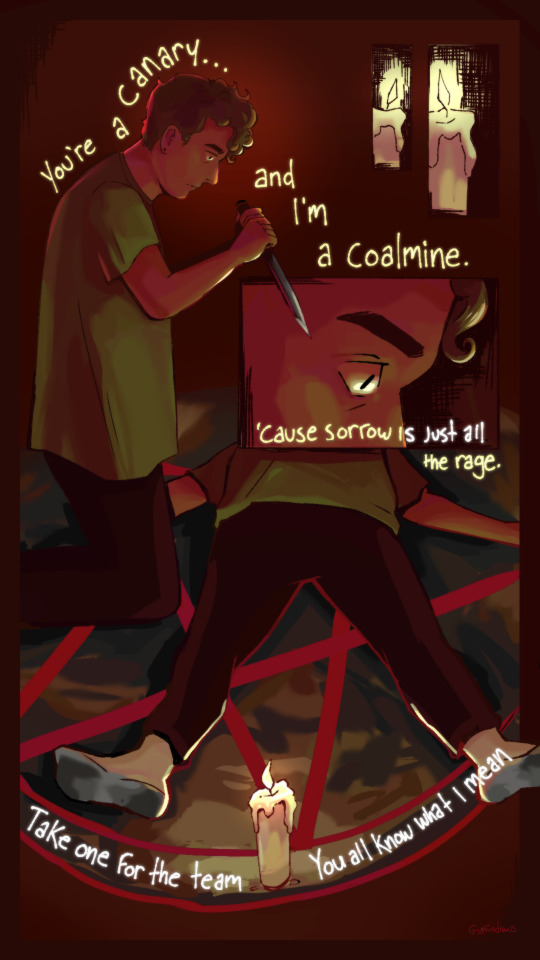

my @phandomgiftexchange gift for @silliestgirlintheworld !! (i signed up under @cryptidjeepers but wanted to post on my art blog, i hope that's okay. I will reblog onto my main as well. sorry for the confusion!!)
when i saw the prompt in my ask box for dan and phil crafts horror i thought they accidentally sent me my own prompt lmao. i was so excited to work on it that i accidentally did two, full-page colour comics. whoops. Also, I know you requested MCR but I don't know enough of their songs so I chose a FOB song (I've got all this ringing in my ears and none on my fingers) it's an absolute banger and weirdly fit this idea i had. I'll drop the version with no text here if that's not your thing! I had a lot of fun drawing this and it was totally out of my comfort zone. I hope you like it! Merry Christmas! :)

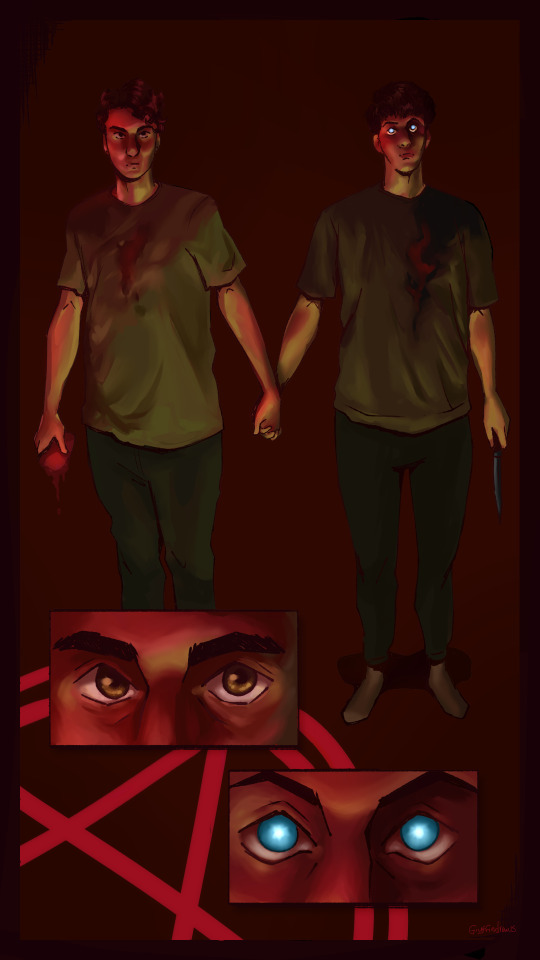
#phandom gift exchange#phandom gift exchange 2024#dan and phil crafts#danandphilcrafts#dan and phil#phan#my art#daniel howell#phil lester#dan howell#phanart#again sorry for posting this on the wrong account i hope this isnt too confusing#this was so insane to draw i literally developed a new painting technique#lore note: i wanted to hint at phil being possessed by something paranormal hence the spooky eyes#phandom#knife tw
285 notes
·
View notes
Text

A little practice drawing! Love these two 💛🖤
#I’m working on some rendering techniques so you’ll probably see a lot of variation in my art for a while#also coloring my lines based on the light. need to develop that a little more I think#also. me and who#my art#fullmetal alchemist#fma fanart#fma#fmab fanart#ling yao#lan fan#lingfan#ship art#NOTHING I love more than doing cold breath in drawings#they r so cute I love them. anyone who depicts ling in a bigass winter coat is 100% correct
248 notes
·
View notes
Text
How to achieve our manifestation in less than three days.
This is a question that is always on everyone's mind because, let's be real, we are all impatient to get our desires as fast as possible. So what can we do to get what we want as fast as possible? Here is THE guide on how to do it.

Is begin "Delulu" the only method to make your manifestation come faster?
People often say that starting with a delusional mindset speeds up manifestation, and you know what? They're absolutely right! Being "delulu" is like wielding a powerful instrument that we can play however and whenever we like.
But why is it so powerful? Because we reprogram ourselves by slowly changing our mindset by faking that everything is already ours, reprogramming ourselves means unlearning things that don’t serve our wellness and replacing them with things that do.
Personally, I find it super effective to envision myself in an interview when I try to manifest, telling the journalist how I became so powerful and how everything I've manifested took little to no time. It works amazingly! I get what I want from the universe in just three days by doing this.

We can speed up our manifestations, not just by affirming and believing that we already have what we desire (which alone is often enough to make things happen faster), but also by applying some of the 12 laws of the universe:
The law of Devine ones:
This principle emphasizes that everything in the universe is intrinsically linked, forming a single, unified whole. It implies that we are all interconnected, not only with each other but also with the source, or universal consciousness. With this law, we simply apply the reality that we are already connected to our desire, even if it has to be created from 0. It is already connected to us, and vice versa.
The law of Detachment 1.0:
The Law of Detachment is a core principle in deductive reasoning and formal logic. It asserts that if a conditional statement (an "if-then" statement) is true and the hypothesis (the "if" part) holds true, then the conclusion (the "then" part) must logically be true as well. I will give a quick example: if I am a witch, then I can do magic (an "if-then" statement), so if I am a witch, and it is true, then the fact that I can do magic is also true. Applying this to manifestations is now as simple as it can be. If I am manifesting this (which is true), then my manifestation is already here (also true).
The law of Detachment 2.0:
The Law of Detachment underscores the importance of trust and surrender. By relinquishing control and not clinging to specific outcomes, you create a state of allowing that can make it easier for your desires to manifest. This approach minimizes stress and resistance, which can otherwise hinder the manifestation process. In essence, the Law of Detachment in manifestation is about balancing desire with surrender. You hold your vision and take steps towards it, but remain flexible and open to how and when it manifests in your life.
The Law of Inspired Action:
Manifestation may require us to take inspired, and intentional action aligned with our desires. This law emphasizes the importance of actively pursuing our goals and dreams while remaining open to guidance and opportunities. For example, if I manifest to go on a great adventure and make a lot of friends along the way, I will have to take the intentional action to book it.
The Law of Rhythm:
Everything in the universe operates in cycles and rhythms. This law suggests that there are natural ebbs and flows, ups and downs, and that understanding these rhythms can help us navigate life more harmoniously. A way that I manifest things is to listen to music that makes me feel powerful and in control of the whole universe. Everyone has this kind of song in their heart because everyone vibrates at a certain frequency and volume. One of mine for example is vampire heart (slowed) - Isak Roen
These laws are not the only way but they for sure are a way. You can use all of them or use only one it is really up to you and i really suggest you learn about the 12 laws because they are a must for manifesting your dream life.

if you are intrested in more intresting way to manifest don't forget to check my masterlist! I hope you have a blessed day or night!
-xoxo the journallo
#manifestation#manifesting#shifting methods#loa methods#manifestation method#manifesation#spiritual development#journal#explain the method#explained#manifestation tips#law of manifestation#law of assumption#how to manifest#law of attraction#neville goddard#loa affirmations#loa tumblr#loassumption#loablr#loa blog#loassblog#loa#manifestation blog#manifestation success story#manifestation techniques#manifestations#manifestingreality
468 notes
·
View notes
Note
I feel like I have nothing to ask, I simply would love to hear more about them fucked up mermaid and murderer
And I would absolutely love to tell you about them, Tin.
This AU takes place somewhere vaguely in the Pacific Northwest (circa. 1970s-80s) in an isolated fishing town along a storm-wracked coast.
Fisheries in and around the bay have collapsed due to extreme winter weather patterns + overfishing + an oil spill from a tanker run aground down the coast, leaving most of the bay's inhabitants to live pretty much hand-to-mouth off contaminated fish in recent years.

get ready for LORE (and more drawings but mostly the LORE)
general warning: this is pretty long
The "story" as it were, kicks off when Gem finally gets fed up with another fisherman in the area, Grian, over continued conflict about ownership of fishing grounds in the mouth of the bay.
She orchestrates his death (with the eager assistance of Scott and Impulse) out at sea and passes it off as a tragic accident in the winter swells with her being the unfortunate finder of his remains.
And it works.
See the thing is: Gem has a history of causing disappearances. It started with some accidents with out-of-town poachers. She would chase these people off and one or two would just slip overboard and happen to drown. It wasn’t her fault and besides they deserve it. But things start to escalate from there. Poachers become outsiders become fellow townspeople. Grian is someone Gem’s known for years, whose friends are tangentially her friends or acquaintances. His death is a cold-blooded murder driven by hatred and frustration. This time something is different about what she's done and Gem knows it.
But Gem is a reputable and well-known person. Her prices are fair, she drives poachers out of the bay and maintains order around the pragmatic fishing ground policy that undoubtedly helps everyone to survive.
She is the type of person to look to for guidance when things get difficult because she can make those hard choices. So how on earth could it be her fault?
No one is wiser until Grian's funeral brings an old friend into town who is more than a little suspicious about the circumstances of his death.
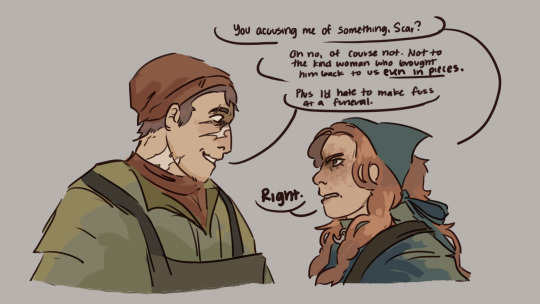
Scar was one of Grian's crewmates when they did trawling much further south. They split when Scar took up (illegal) whaling and Grian moved into the bay.
As an outsider, Scar isn't so swayed by the goodwill the town has around Gem's name. He's no detective but for the sake of an old friend, he might as well try.
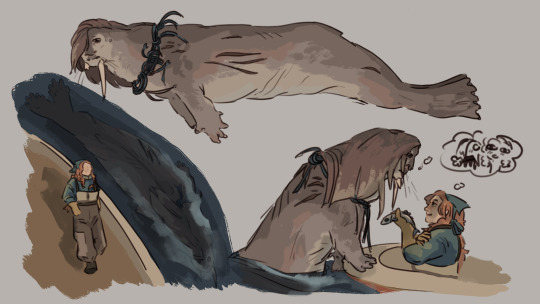
In this AU, mermaids are social mammals part of the Hominidae family that went back into the ocean similar to Cetaceans. They live in matrilineal family groups or in any other female-led organization of pods and have a very "survival-oriented" global culture (with regional variation).
Pearl is a lone mermaid whose pod lived in the bay until they were starved out by the collapsing fisheries. PNW mermaids are more territorial than other ecotypes and value strength over anything else. Pearl's inability (read: unwillingness) to oust other pods for better fishing grounds and the loss of one of her pod members summarily lead the other two to abandon her.
Without a pod to help her, hunting enough in her dwindling territory has been difficult and lonely, leading her to slowly starve just as the humans in the bay have begun to.
She took to trailing fishing boats to steal from their catch, which is how she met Gem who was mid-throwing some unfortunate soul overboard.
They have an interesting relationship.
Gem is enamored with Pearl at the halfway point between a person and a large apex predator. She loves the way Pearl needs her to live and the way Pearl, as a social creature with no pod, craves her attention. It's thrilling to have a predator at her beck and call like this and, in turn, to be so desperately needed. She also loves the way Pearl doesn't look at her like she's dangerous (the way Scott and Impulse have begun to when they think she doesn't see them). Her interest in Pearl seems to be leaching into something more than just wildlife admiration. She's begun to learn the mermaid language just to talk to her. For what? Who really knows. Meanwhile, Pearl is hungry enough to eat just about anything Gem throws her (including human bodies) and desperate enough that she lets Gem get much closer than many humans in this area have ever been to a mermaid. (They even touch, scandalous for mermaids.)
It's skewed for sure. From Gem's perspective, they've got something special going on. From Pearl's... not so much.
This being Secret-Life based, you can imagine how this story ends...

Bonus piece: Pearl and her old pod.
IN GENERAL, Biological females are generally larger with a set of rotated tusks protruding from their lower jaw for dominance displays. Biological males are commonly smaller and more agile, with more dexterous hands due to decreased adipose tissue distribution over their bodies. (They actually have 3 biological sexes and tons of social gender variation but that's a talk for another time). Pre-cultural awakening, these pods would form around a biological female and their harem for reproductive purposes. That female would then protect the harem from other females looking to "steal them" or their territories (like horses but reverse-style). In modern times, these pods are often composed of groups of friends/related family members as sort of "platonic life partners" and stealing other pod members is seen as a very archaic sort of thing. Territory stealing, however, is still up for grabs.
#fishgutsau#pearlescentmoon#geminitay#grian#goodtimeswithscar#impulsesv#scott smajor#wild life smp#shinyduo#implied gempearl#tagged for blog curation purposes#tried out a new color technique with the sketches and im so happy about it ngl#looooooong ramble about this au because its very developed and i love it very much#also the mermaids have SO MUCH LORE due to my unique mental illness but the post is long enough as it is#i even covered reproduction its never mentioned in this au but trust me there is no stone unturned#tw murder#tw cannibalism??#also this fits nowhere but i wanted to say etho-mermaid is like the hottest guy around in mermaid society#they (read: joel and bdubs) love his lone wolf swagger#pearl on the other hand has a thing for the color orange#my art#squawk talk#rough work
203 notes
·
View notes
Text
Emotion doesn’t live in the moment it’s named. It lives in the moment it’s shown.
A guide to writing emotion that lingers.
Writers are often told to “show, not tell,” but when it comes to emotional scenes, that advice can feel vague. What does showing emotion actually look like on the page?
Let’s start with this:
“She was heartbroken.”
“He was furious.”
“They were in love.”
These lines tell us what to feel — but they don’t make us feel it. And the truth is: naming the emotion is often the least emotional way to express it. Because real emotion — the kind that stays with the reader — doesn’t come from labels. It comes from subtext. From silence. From contradiction. From tension.
1. People rarely say what they feel directly. Neither should your characters.
In life, we often mask our deepest feelings — out of fear, shame, pride, or the desire to protect someone else. Let your characters do the same.
Instead of:
“I’m afraid you’ll leave me.”
Try:
“Don’t make promises you can’t keep.”
(Said too quickly, with their hand pulling back.)
Instead of:
“I love you.”
Try:
“You never let anyone close, do you?”
(Said while brushing their fingers against a sleeve, then looking away.)
Emotion lives in what your characters almost say. The tension between what’s spoken and what’s felt is where the magic happens.
2. Let body language contradict the dialogue.
Emotion slips through the cracks. You can reveal everything without a single explicit word.
“I’m fine,” she says — while clenching her jaw and staring at the chipped mug he gave her last winter.
He says he doesn’t care. But he hasn’t touched his drink. He keeps checking the door.
These contradictions signal to the reader that what’s being said is not what’s truly felt — and that discrepancy creates emotional depth.
3. Use objects, routines, and settings to reflect emotional states.
Sometimes what a character does with their environment tells us more than what they say.
A character grieving might keep reboiling tea, never drinking it.
A character in love might fold their lover’s scarf and place it beside the pillow, carefully, as if it matters.
A character afraid of confrontation might suddenly fixate on straightening the books on a shelf mid-argument.
This technique is especially powerful when a character is trying to repress what they feel. Let the emotion spill into the physical world around them.
4. Interruptions and hesitations matter.
Don’t be afraid of silence. Use fragmented dialogue. Let the rhythm break.
“I just—”
“What?”
“Nothing. It’s stupid.”
(But she’s twisting the ring on her finger like it’s the only thing anchoring her.)
These moments tell us: there’s something beneath the words. Something unsaid. Something important. That tension pulls the reader deeper.
5. Show how emotion distorts time, memory, and logic.
Strong emotion changes perception.
A character in panic might notice every sound but can’t remember how they got from one room to another.
A character in love might focus on the way light moves across someone’s cheek and forget their own name for a second.
A character in shock might hear someone talking but not register the words.
These small distortions add layers of realness to emotional scenes. They show us that something profound is happening internally — even if externally, everything is quiet.
So how do you make your readers feel something?
You don’t do it by naming the emotion.
You do it by crafting a moment that requires the reader to step closer. To observe. To interpret. To feel it themselves.
Let the reader discover what your character can’t say. Let them understand it before your character does.
That’s when emotion becomes unforgettable.
That’s when your story sticks.
#writing#writeblr#writers of tumblr#writing tips#writing advice#amwriting#writing community#creative writing#show don't tell#writing emotions#character development#sub text#emotional writing#writing craft#writing techniques#haunting prose#writing with feeling#soft dark academia#dark academia#moody writing#romantic writer#character driven#vibsinkpot
100 notes
·
View notes
Text

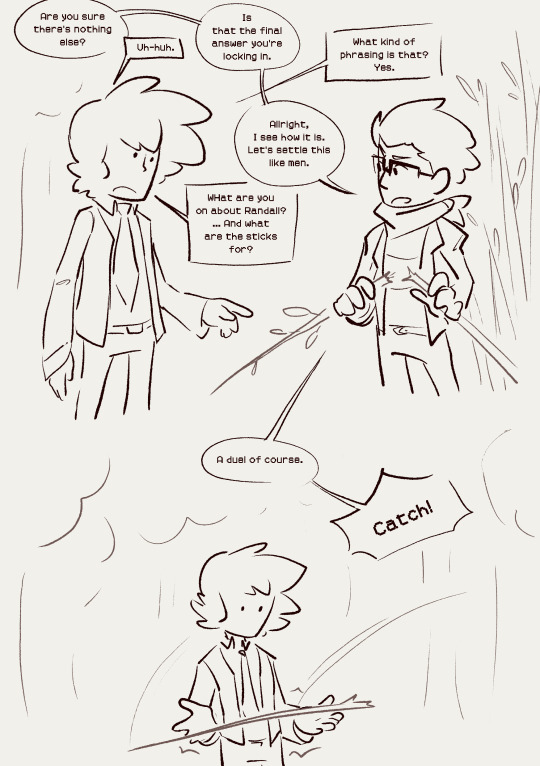
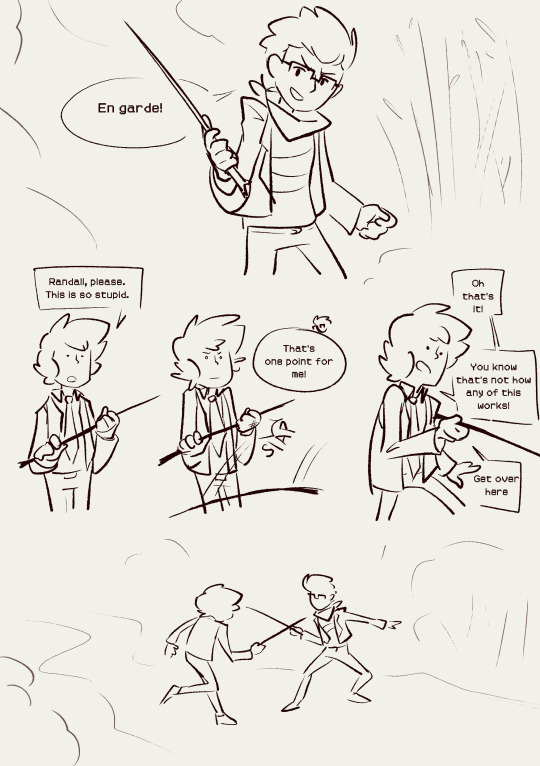
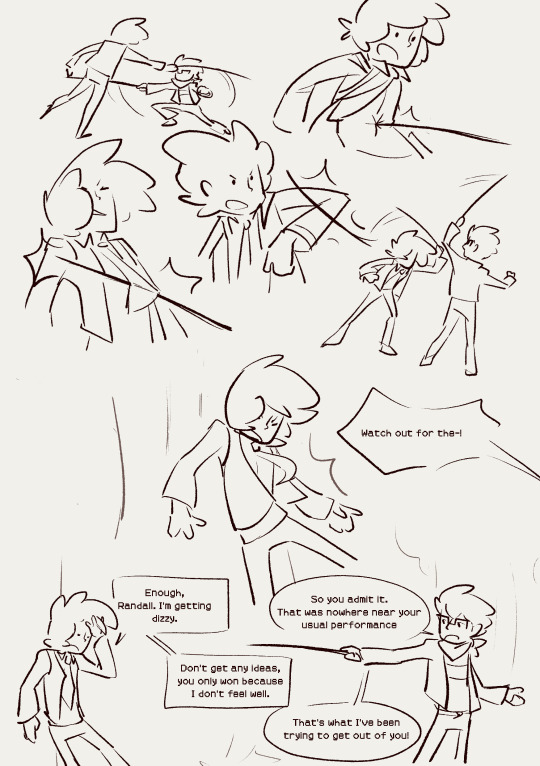
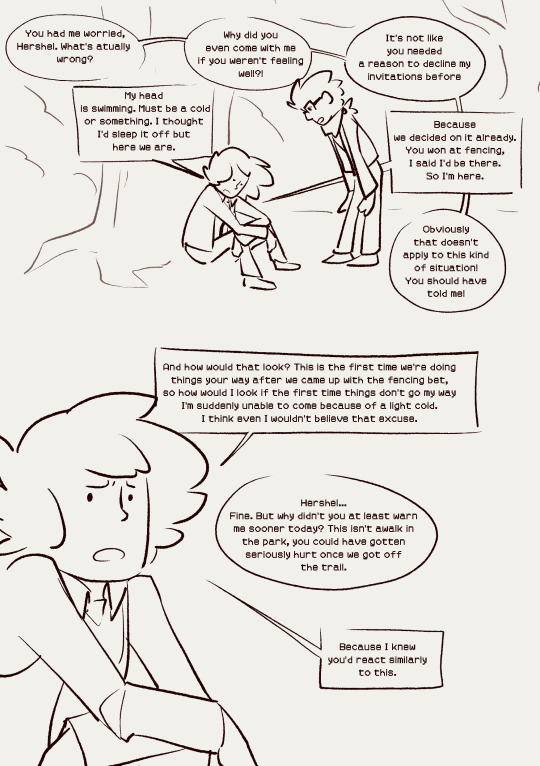
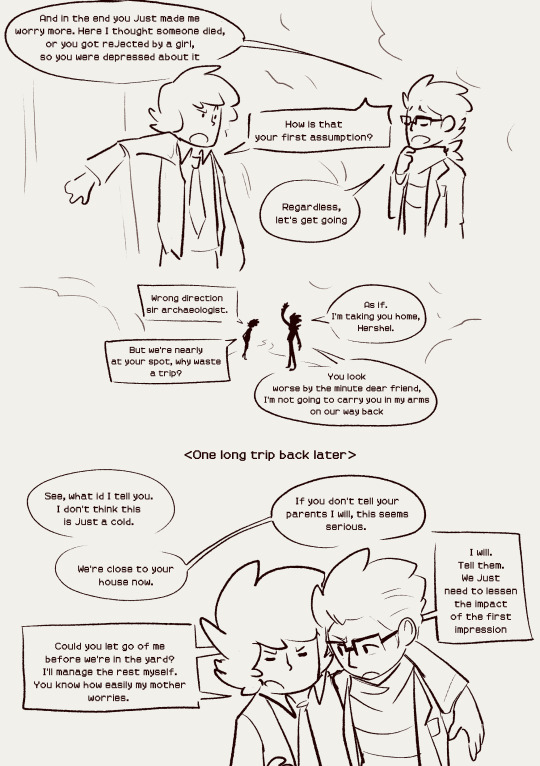
Woops, hand slipped and I turned your mystery game into a teen drama
#drawing stuff for the game im nowhere near beating again ayyy; obligatory i might not know something that messes up the whole thing; anyway#we got some cranky stundere sick hershel; we got some early stick-instead-of-sword technique developing;#we got some creative problem solving from Randall#Froshel showed up to school the next day too; randall nearly beat his ass again#I'm running off the assumption that they generally decide what to do on weekends by way of fencing and not just that one time™#I like one trope and I have the ability to draw so I draw one trope if you follow me you get hurt/comfort that's it#professor layton#hershel layton#randall ascot#professor layton miracle mask#ranlay#hurt/comfort#my art
118 notes
·
View notes
Text

Commission for my friend Dame!!!!
#this is the silliest one i have done in a little bit :)#also genuinely#ive done so many commissions for dame over the years#and its honestly so sweet of them to be my patron basically#a lot of their commissions have pushed me to grow and develop my style + learn new techniques#and being financially supported is really nice#either way#ily dame#art#digital art#sonic#2017 x#sonic.exe#2017x#EXE#sonic exe#sonic exe 2017#creepypasta#commission
348 notes
·
View notes
Text

i heard that star wars went woke and added witchy lesbians who use the force to have babies, and RAN to redraw an old piece of my force baby oc myre 'n their kiffar oracle mum syna
og piece below↓

#very proud of my improvement ngl. 3 year diff!!!#myre's a wonder woman type of force baby tho: syna molded them out of clay from a midichlorian pool bed. added part of her life force to-#-the clay via reverse psychometry [a technique she developed] .dipped myre in the pool and then used force lightning to bring them to life.#syna's not that good of a mom tho unlike osha and mae's moms lmao#and syna has no qukuuf cause i have lore[tm] for the kiffar and she's from the era before qukuuf was tattooed. and just painted on#my art#sketch#digital art#star wars#star wars oc#star wars fanart#kiffar#myre#syna
203 notes
·
View notes
Text
Javier, after walking in on Lloyd doing high level magic out of nowhere: .....
Lloyd: I can explain.
Javier: Can you?
Lloyd, sighing: no, probably not.
#ok not a joke; but Javier's decision to pretend to not notice all the weird shit Lloyd pulls used to fascinate me#because Javier is; and I say it with love; a weird little mule guy who just HAS to dig as deep as he can to literally everything he sees#until he reaches the absolute truth#that's one of the reasons why he's such a talented knight. He tries out every option available to him in terms of mana and techniques#and ends up finding some new kickass technique#do you remember he just out of nowhere invented chainsaw?#Javier can't help it he will dig. And he will dig deep.#but with Lloyd; he just decided to trust this weirdo of a master#not implicitly of course. he did test him#but it's fascinating how he allowed himself to trust Lloyd#greatest estate designer#greatest estate developer#lloyd frontera#incorrect greatest estate developer#javier asrahan#incorrect quotes#tged#incorrect tged#They're si good at ignoring each other's oddities
72 notes
·
View notes
Text
How to Write Intimacy That Stays Uneven
Intimacy isn’t always mutual.
It isn’t always soft.
And whether romantic or not, the moments that haunt most are the ones that go unanswered —
where one person sees too much, and the other says nothing.
This kind of intimacy doesn’t resolve.
It exposes — and leaves the space unclosed.
Here’s how to craft that tension deliberately:
• Let one character notice what the other is trying not to show.
• Use silence not as peace, but as pressure.
• Keep physical distance, but emotional visibility.
• Don’t resolve the power imbalance. Let it tilt.
• Let the emotional weight stay where it falls — without relief.
She says it once.
He doesn’t answer.
And they both pretend the moment didn’t happen.
This isn’t about connection.
It’s about risk without response.
Someone has been seen.
The story keeps moving. But the balance never resets.
#writeblr#fic writing#writers on tumblr#writing#ao3 writer#ao3 author#quillver#female writers#ao3 fanfic#ao3fic#writing craft#writing advice#writer tips#writer thoughts#writing process#fiction writing#writing life#writing tips#writing techniques#writing emotions#character advice#character development#tumblr writing community#writers community#fanfic community#writer community#amwriting#show don't tell#narrative power#complicated relationships
29 notes
·
View notes
Note
Can I get uhhhhh Pained Dirk or Surprised Kanaya? :3
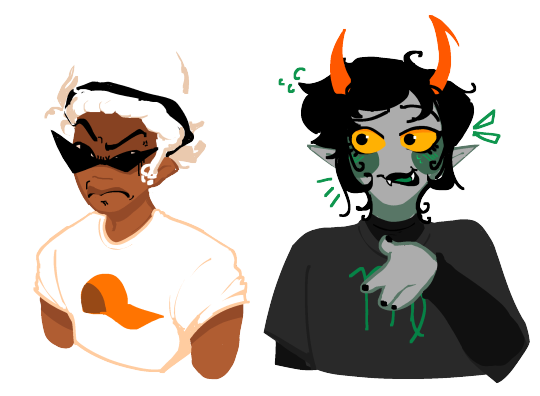
you can get...... BOTH!!!
#YAAAAH YAYA!#these were fun :D!!!#i've never drawn the canon characters with headcanons/personal flare before so this was a fun challenge....#i will develop them further....#strengthen my ways and techniques...#but yaaaay thank you nort!!#hope you enjoy!#i'm gonna reblog with individual transparent versions in cause anyone wants them?#but yeah!!#dirk strider#kanaya maryam#expression meme answer#homeshit#hs#hs fanart#homestuck fanart
30 notes
·
View notes
Text
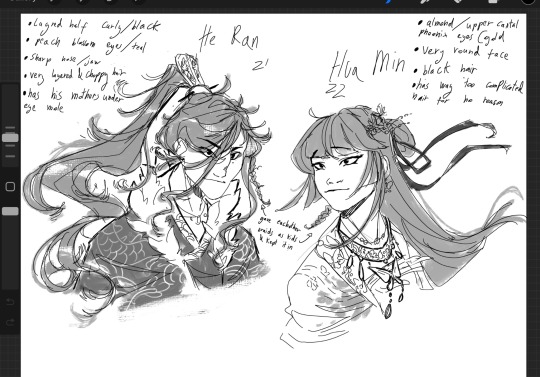
Uhhhhh locked in too hard and now I have a Hualian and Beefleaf fankid au and uhhh
#yeah this is getting way too out of hand#like it was a joke but now they all have fully fleshed out lore and lives#Hua Min has a younger sister whos name… I have not come up with#but uhhhh Hua Min because Hua cheng and Min was Xie lians mothers family name so it’s a way of honouring her#and He Ran just sounds cool idk what to tell you#they’re both essentially siblings as they kinda grew up together p much#like actually the worlds worst behaved kids#think two WWXs and it pisses everyone off because like my god they’re child prodigies but lord you wouldent think it’s#grew up to become immortals famous for their cultivation technique development that they fine tuned specifically for demon hunting#they’re both rly prone to action and are very skilled with multiple weapons#uhhhh idk I gotta think more but alas I have brain worms#my art#tgcf#heaven official's blessing#mxtx#danmei
32 notes
·
View notes
Text
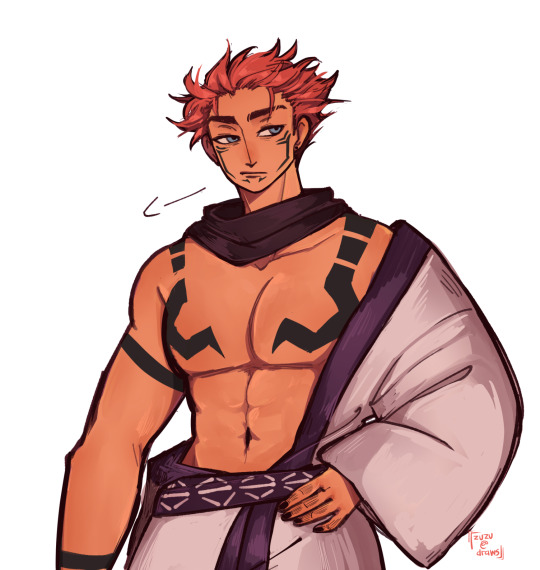
Heian Era! Sukuna, back when he was a human Curse-Sorcerer ; If Gege won't give him to us, I will =_=
#ryomen Sukuna#Sukuna#jujutsu kaisen#jjk#jjk fan art#my art#fan art#human sukuna#heian era#curse sorcerer#jujutsu sorcerer#We got that ''love'' comment by the narrator again#i don't get why Gege is so stingy with regards to Sukuna's lore#like For God's sake please develop him and his backstory already i'm so tired of waiting; Give us his Cursed technique while your at it too#gonna do a bit of PR for my goat Sukuna though <3 you'll always be my number 1#I think it's possible he may have had blue eyes when he was human or perhaps his OG form still has them#i think it fits in the color palette rather nicely too :p#wanted to add less beef on him too but i guess that didn't work out :T#curse user#jjk sukuna
626 notes
·
View notes